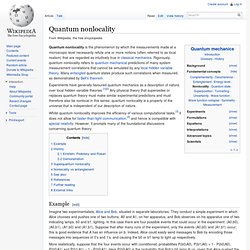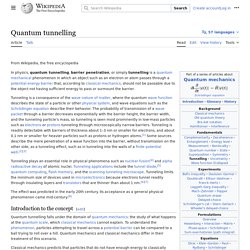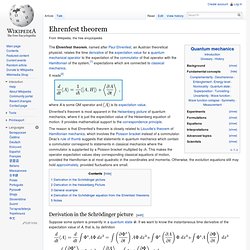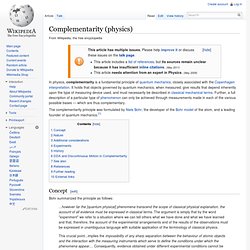

Quantum nonlocality. Quantum nonlocality is the phenomenon by which the measurements made at a microscopic level necessarily refute one or more notions (often referred to as local realism) that are regarded as intuitively true in classical mechanics.

Rigorously, quantum nonlocality refers to quantum mechanical predictions of many-system measurement correlations that cannot be simulated by any local hidden variable theory. Many entangled quantum states produce such correlations when measured, as demonstrated by Bell's theorem. Quantum tunnelling. Quantum tunnelling or tunneling (see spelling differences) is the quantum mechanical phenomenon where a subatomic particle passes through a potential barrier.

Quantum tunneling is not predicted by the laws of classical mechanics where surmounting a potential barrier requires enough potential energy. Quantum tunnelling plays an essential role in several physical phenomena, such as the nuclear fusion that occurs in main sequence stars like the Sun.[1] It has important applications in the tunnel diode,[2] quantum computing, and in the scanning tunnelling microscope.
The effect was predicted in the early 20th century, and its acceptance as a general physical phenomenon came mid-century.[3] Fundamental quantum mechanical concepts are central to this phenomenon, which makes quantum tunnelling one of the novel implications of quantum mechanics. History[edit] After attending a seminar by Gamow, Max Born recognised the generality of tunnelling. Ehrenfest theorem. It reads[2] where A is some QM operator and is its expectation value.

Ehrenfest's theorem is most apparent in the Heisenberg picture of quantum mechanics, where it is just the expectation value of the Heisenberg equation of motion. It provides mathematical support to the correspondence principle. Quantum decoherence. Pauli exclusion principle. A more rigorous statement is that the total wave function for two identical fermions is anti-symmetric with respect to exchange of the particles.

This means that the wave function changes its sign if the space and spin co-ordinates of any two particles are interchanged. Integer spin particles, bosons, are not subject to the Pauli exclusion principle: any number of identical bosons can occupy the same quantum state, as with, for instance, photons produced by a laser and Bose–Einstein condensate. Overview[edit] "Half-integer spin" means that the intrinsic angular momentum value of fermions is (reduced Planck's constant) times a half-integer (1/2, 3/2, 5/2, etc.). History[edit] Measurement in quantum mechanics. Uncertainty principle. Where ħ is the reduced Planck constant.

The original heuristic argument that such a limit should exist was given by Heisenberg, after whom it is sometimes named the Heisenberg principle. This ascribes the uncertainty in the measurable quantities to the jolt-like disturbance triggered by the act of observation. Though widely repeated in textbooks, this physical argument is now known to be fundamentally misleading.[4][5] While the act of measurement does lead to uncertainty, the loss of precision is less than that predicted by Heisenberg's argument; the formal mathematical result remains valid, however.
Since the uncertainty principle is such a basic result in quantum mechanics, typical experiments in quantum mechanics routinely observe aspects of it. Certain experiments, however, may deliberately test a particular form of the uncertainty principle as part of their main research program. Introduction[edit] Click to see animation.
Wave–particle duality. Origin of theory[edit] The idea of duality originated in a debate over the nature of light and matter that dates back to the 17th century, when Christiaan Huygens and Isaac Newton proposed competing theories of light: light was thought either to consist of waves (Huygens) or of particles (Newton).

Through the work of Max Planck, Albert Einstein, Louis de Broglie, Arthur Compton, Niels Bohr, and many others, current scientific theory holds that all particles also have a wave nature (and vice versa).[2] This phenomenon has been verified not only for elementary particles, but also for compound particles like atoms and even molecules. For macroscopic particles, because of their extremely short wavelengths, wave properties usually cannot be detected.[3] Brief history of wave and particle viewpoints[edit] Thomas Young's sketch of two-slit diffraction of waves, 1803 Particle impacts make visible the interference pattern of waves. Complementarity (physics) In physics, complementarity is a fundamental principle of quantum mechanics, closely associated with the Copenhagen interpretation.

It holds that objects governed by quantum mechanics, when measured, give results that depend inherently upon the type of measuring device used, and must necessarily be described in classical mechanical terms. Quantum entanglement. Quantum entanglement is a physical phenomenon that occurs when pairs or groups of particles are generated or interact in ways such that the quantum state of each particle cannot be described independently – instead, a quantum state may be given for the system as a whole.

Such phenomena were the subject of a 1935 paper by Albert Einstein, Boris Podolsky and Nathan Rosen,[1] describing what came to be known as the EPR paradox, and several papers by Erwin Schrödinger shortly thereafter.[2][3] Einstein and others considered such behavior to be impossible, as it violated the local realist view of causality (Einstein referred to it as "spooky action at a distance"),[4] and argued that the accepted formulation of quantum mechanics must therefore be incomplete. Quantum superposition. Wave function. However, complex numbers are not necessarily used in all treatments.

Louis de Broglie in his later years proposed a real-valued wave function connected to the complex wave function by a proportionality constant and developed the de Broglie–Bohm theory. The unit of measurement for ψ depends on the system. For one particle in three dimensions, its units are [length]−3/2. Quantum state.